October 31, 2023 – Volume 25, Issue 10
In This Issue
- Flanigan’s Net Positive: Bloated Cars
- The GHG Disclosure Train
- Inverting Utility Resilience
- Heat Pumps – The Basics
- Filling the Tree Equity Gap
- Rural Electrification: The Maldives
- Ireland’s Bold Green Move
- Northeast Offshore Wind’s Ups and Downs
- Flanigan’s Ego-Logic Podcast Updates

Flanigan’s Net Positive: Bloated Cars
The sharp 77% rise in U.S. pedestrian fatalities is being partially blamed for the fact that cars have become bigger. From 2011 to 2021, the annual number of pedestrian deaths increased from 4,302 to 7,624. During the same time frame there was a 25% increase in all other types of traffic fatalities.
Big cars are to blame, at least in part. An article in The Conversation by Professor Kevin Krizek from the University of Colorado caught my eye. Bloated cars. Krizek is coming from a public safety standpoint. He points out that light trucks injure pedestrians more severely and that the size of cars and trucks sold in the United States “continues to swell.” The Toyota Rav 4 is one-third larger than it was 15 years ago. Overall, we have larger and heavier cars.

Image Courtesy of Autoevolution

Image Courtesy of Autoevolution
Part to blame is the nature of the Corporate Average Fuel Economy (CAFE) standards. Krizek points out that there is one set of rules for cars, another for light trucks. SUVs are classified as light trucks. Thus automakers have focused on the manufacture of sport utility vehicles and light trucks, they’ve moved away from producing more efficient small cars and sedans. Their showrooms are dominated by SUVs, minivans, and pick-up trucks. Three-quarters of new vehicles sold are classified as light trucks. That’s an inversion of the proportion of light trucks to passenger cars. In 1990, cars were 60+% of sales.
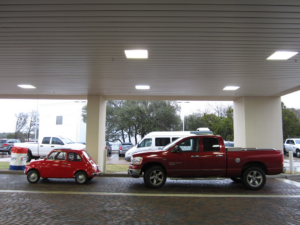
Larger vehicles are hazardous for bikers and walkers. Taller vehicles strike their victims higher, causing head and neck injuries versus leg injuries. Vehicles’ larger frames worsen visibility for their drivers, especially when turning. One solution being proposed by the National Highway Safety Administration is to add criteria for crash-test ratings that reflect how well a vehicle does in a crash in terms of protecting the victim. Bumper and front panels can be designed to bend more easily and to absorb more energy, lessening injuries.
Tackling the car bloat is ultimately about transforming social expectations. Krizek notes that Amsterdam and Copenhagen were not always pedestrian safe. Then in the 1970s, those cities began restricting cars. He notes that, “The goal is to modify the design of neighborhood streets and parking areas in a way that prioritizes pedestrians, bicycles, and new forms of personal transport like micro-cars.”
So what to do? A national survey shows that more than half of trips in America are less than four miles. This strongly suggests a targeted, policy medley of carrots and sticks to discourage people from using large passenger vehicles for short trips. Start with prioritized parking for bikes and smaller vehicles, then shift to smaller parking spots. Narrow travel lanes force drivers to slow down; any saved space can be reapplied to bike lanes and sidewalks. Cities can limit or eliminate vehicle traffic near schools and other highly trafficked commercial areas, permanently or at high-use times of day. Another option is weight-based registration fees.
Krizek makes clear that all of these options will make pedestrians and bikers safer by restricting bloated cars. And, by doing so, our cars will become more efficient… cutting fuel costs, boosting national security, and cutting emissions.
Quote of the Month
“As the longest-serving renewable energy retailer, we’ve got the experience. We’ve been dedicated to changing the way power is made and helping people lead greener lives for over 20 years. Plus, we offer green living tools and resources that will help you make a greater impact on the planet; ranging from carbon offsets, to plans that come equipped with smart thermostats and sensors, to the ability to track your environmental impact and earn green badges with our Green Mountain App.”
The GHG Disclosure Train
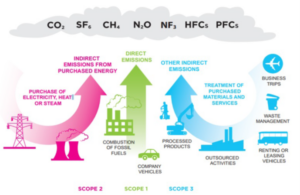
See the train coming? No? I think in a matter of years, every business, school, church, and even our homes… will be reporting Scope 1,2, and 3 greenhouse gas emissions. The GHG disclosure train is on the tracks and heading our way. Soon we will all be accountable for our emissions. There will be limits and exchanges. Of course it all starts with the big players… later working its way down to each business, perhaps each home.
Hold on… What’s new? A new bill is making its way through the California legislature that will require ~5,300 companies to report their greenhouse gas emissions. The goal is to increase transparency and to nudge companies to evaluate how they can cut their emissions. Seventeen states, including California, already require their largest polluters to disclose their emissions because of the State’s cap and trade program. The new bill would require companies to report on their emissions “up and down the supply chain”… reporting both direct and indirect emissions. Indirect emissions include those related to transporting products, business travel, and disposing waste.
This new law would require emissions reporting based on dollars of business instead of levels of emissions, based on how much money they make, not how much emissions they release. There are lots of big companies in California that manufacture, export, and sell, from electronics to transportation equipment and food. Almost every major company in America does business in California. The State is one of the world’s largest economies. Its bold climate action is notable.
California is pushing to make emissions transparent and accountable. A similar bill didn’t pass last year, but a stronger coalition is behind it now with the support of Patagonia and Apple. If the bill passes into law, major corporations that earn more than a billion dollars each year will have to disclose their direct and indirect greenhouse gas emissions. If it passes, it will be the most sweeping mandate of its kind in the nation.
The bill needs California Senate approval before reaching the governor’s desk. Newsom has not stated his position on the bills, but is a champion of measures to address climate change, pushing the State’s transition from gas-powered vehicles and expanding wind and solar. California seeks to cut 40% of its emissions by 2030.
Inverting Utility Resilience
This past week, Green Mountain Power in the State of Vermont, made a bold proclamation that it is taking the path less traveled. Prompted by severe weather, the utility is taking “ the soft path.” Since 2013, major storms have caused $115 million in damages across GMP service territory. Fully 40% of that has been in the past two years.
GMP is now planning for zero outages by 2030… in a new way. Instead of resilience through N-1 power schemes and redundant power plants, Green Mountain Power is planning resilience at the household level – at the very end of the distribution line. It is planning to install battery storage systems in all of its 270,000 customers’ premises by 2030.
The battery installation goal is part of GMP’s 2030 Zero Outages Initiative. Its goals are to make existing power lines more resilient, to bury power lines, and to install residential battery energy storage for all customers. A successful tactic has been GMP’s use of “spacer cables” on its distribution lines that are resistant to trees falling on them, greatly reducing tree-caused outages. Batteries will be deployed in remote locations first, then rolled out for all customers. The plan has been filed with the Vermont regulatory commission.
GMP already offers a home battery program in which its customers can lease a Tesla Power Wall and other brands for $55 a month. As such, the customer has backup power. When not needed, the back-up power flows back into the grid. About 5,000 systems have been installed and the program has a long waiting list. Now regulators have agreed to lift the cap on participation in the program. GMP is also creating “Resiliency Zones” with microgrids in sections of towns.
Heat Pumps – The Basics
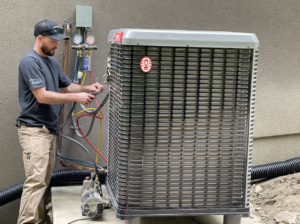
Heat pumps are a bit like magic. Like a refrigerator, a heat pump can cool your food. Like an air conditioner, a heat pump can cool your home. The heat pump pulls heat out of indoor air and expels it outside. Then in the cold of winter, the system is reversed and the heat pump collects and pulls heat from the cold outdoor air and transfers it indoors.
Unlike traditional heaters, natural gas and heating oil, heat pumps do not burn fuel. Instead they use electricity to compress and move gasses. They do not attempt to generate heat. Instead they capture and move heat. At the core of heat pumps, a refrigerant absorbs and rejects heat. A compressor pressurizes the refrigerant and moves it through the system.
Currently 16% of American homes use heat pumps. Traditionally, they have been used in milder climates. But thanks to advanced technology, they are now being used in all American climate zones.
There are two basic varieties of heat pumps, air-sourced and ground-sourced. The ground-source heat pumps are also called geothermal heat pumps. Ground-source systems are usually more expensive to install, but are more efficient in operations given the consistent temperatures in the soils in which their coils are embedded. They are good to install during home construction. For retrofits, horizontal boring now makes ground-source systems much less invasive/disruptive to install.
Another type of heat pump is water-sourced, typically taking and putting energy from and into a pond. Air-to-water heat pumps distribute heat through hot water radiators. Absorption heat pumps are another permutation. They use ammonia in the heating and cooling cycle.
Back to the magic of heat pumps. They use a unit of energy to “create” (actually collect and distribute) three to four times that unit’s value in captured heat. Grist perhaps conservatively reports that heat pumps cut GHG emissions by 45% compared to gas furnaces.
Furnaces are rated in terms of their Seasonal Energy Efficiency Rating (SEER) value, and Heating Seasonal Performance Factor (HSPF). The new federal standard for conventional heating for residential units is SEER 14, HSPF 8.8. The most efficient heat pumps are SEER 33.1 and HSPF 14.
Buildings are responsible for 34% of GHGs. Ten states are adopting zero emissions standards for space and water heaters including California, New York, and Hawaii. In September, the U.S. Climate Alliance and 25 governors promised a four-fold increase in the use of heat pumps, for 20 million units to be installed by 2030. Further, the Alliance pledged to guide 40% of these units to disadvantaged households and communities.
Filling the Tree Equity Gap
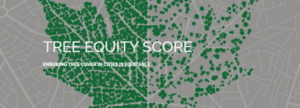
Image Courtesy of American Forests
The Tree Equity Score was developed and recently updated by American Forests, an organization that claims to be the nation’s first conservation non-profit organization. American Forests developed the Tree Equity Score to address damaging environmental inequalities in tree distribution common to cities and towns all across the U.S. and to guide investments in critical urban tree infrastructure, starting with neighborhoods with the greatest needs.
In 2021, American Forests conducted a major urban tree equity study involving 3,810 municipalities. It found the need to plant 31.4 million trees – a 10% increase – in major urban environmental areas across the country to address an equitable balance of trees and to have enough trees for optimum health. The report flagged just how unevenly trees are spread, how much this disadvantages communities of color and the poor. Each city got a score based on socioeconomic metrics, population density, and existing tree cover.
The key findings: Trees are especially lacking in neighborhoods where minorities live, and more prominent in white affluent neighborhoods. Neighborhoods with a majority of people of color have 33% less tree canopy on average than majority white communities. Neighborhoods in which 90% or more of the residents are living in poverty have 65% less tree canopy than those communities with less than 10% in poverty.
Ben Jealous, Executive Director of the Sierra Club, wrote an editorial in the Chicago Sun Times in July in which he argued for greater tree equity. That’s just plain and simply, and in my own words, more trees in impoverished urban areas.
Roughly 80% of Americans live in urban areas and 80% of those city dwellers live in neighborhoods with less than 20% tree cover. Places with minimal tree canopy experience significantly higher temperatures than green neighborhoods.
In areas with minimal tree cover, the amount of pavement, concrete, and glass overwhelms leafy trees, if there are any at all. Researchers have found that quality of life indicators are linked to a lack of trees and shade canopy… .things like health (heat stroke, asthma), air pollution, flooding, energy costs, and home values.
Jealous notes that, “The place where people of color and low-income white live get far less relief from trees… Impoverished communities have 41% less canopy than those with nearly no poverty. This is called the “tree equity gap” by American Forests.” And the gap needs to be filled. Shade trees are for all, advocates exclaim. “We can’t overlook the fact that urban trees help everyone,” avoiding the need for air conditioning and the power plants that it requires and the carbon that they emit.
Good news: The federal spending package approved last year that is driving American manufacturing and clean energy, includes $1.5 billion for planting and maintaining urban trees. That’s 25 times more than the federal government has spent on urban forestry in most years. Given an average cost to plant an urban tree of $300, as many as five million trees will be planted and we will, “close a sliver of the tree equity gap.”
The benefits of trees are clear: They promote physical activity, mitigate heat waves, lower urban heat island temps, and remove particulates from the air, breathing out oxygen. But American Forests predicts that the U.S. will lose 8.3% of its urban trees by 2060 due to storms, construction, and insects. To counter that, some cities have invested in tree equity. Los Angeles Mayor Eric Garcetti appointed a City Forest Officer in 2019 to oversee the planting of 90,000 trees, focusing on neighborhoods that lack shade.
Rural Electrification: The Maldives
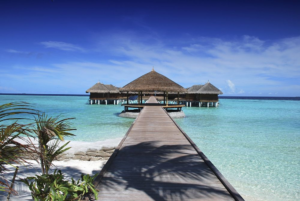
The Maldives is a Pacific Island nation of 1,200 islands. Its 550,000 person population lives on 187 islands. The capital is Male.
In 2022, the Maldives was crowned the World Leading Destination for the third consecutive year at the World Travel Awards. It is a country known for its natural beauty, coral and fish life. It attracts 1.7 million tourists each year. Soon they will see a 5 MW solar system as they arrive at the Male airport and take the highway linking the airport island to Male and its satellite town of Hulhumale.
The country is heavily dependent on tourism and has a heavy dependence on oil imports. The Maldives government has succeeded in electrifying – it boasts a 100% “connectivity rate” – but now is 100% dependent on fossil fuels to power generators. As such, the Maldives has the highest rates of carbon emissions per unit electricity in the region. This is in stark contrast to the country’s reputation of being pristine, perhaps the last natural paradise on the planet, say scuba and beach enthusiasts.
In 2020, President Solih proclaimed that his country would be net zero carbon by 2030, a very aggressive timeline. Due to climate change, his country is threatened by sea level rise and significant loss of land. Each island gets electricity through a diesel-powered mini-grid, a solution that costs the country about 30% of its annual GDP in oil imports and subsidies. So any oil savings help consumers and the government.
The World Bank reports that many developing countries are, “caught in a poverty trap.” Renewables have high up-front costs that will save and save over time. But the status quo is fossil-fueled and results in expensive operating costs and environmental consequences. The World Bank has two key programs to address this barrier, ARISE and ASPIRE. They support private sector investments by offering a “robust risk mitigation” package with loss guarantees. In the Maldives, ARISE provided $12.4 million and has leveraged over $140 million in private-sector investments. The two programs are on target to install more than 53.5 MW of solar and 50 MWh of battery storage.
In turn, the subsidized projects are attracting investors and are driving down costs: In 2014 and for its first 1.5 MW of solar, the country was able to get a PPA for 21 cents/kWh. The price dropped precipitously in 2020 for 5 MW to 10.2 cents/kWh. By 2022, investors were keen to propose projects and the winning project was procured for 9.8 cents/kWh.
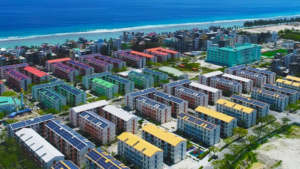
Image Courtesy of Ministry of Environment
A recent editorial by Shauna Aminath, the Minister of Environment, Climate Change, and Technology for the Maldives, points out the huge need for financed mini-grids and distributed renewables. And the challenge is amplified, she says, as projects there have the huge hurdle/barrier imposed by higher interest rates for loans given the country’s unstable political economy. She makes clear that her country is a new and fragile democracy. This speaks to the importance of support from the Asian Development Bank, the World Bank, and others.
An urban microgrid company in the Congo, Nuru, also reports paying high interest rates… up to 15% to finance its systems. To pay the upfront costs, that company has turned to the Bezos Earth Fund, the Rockefeller, and IKEA foundations for support.
Ireland’s Bold Green Move

In what is being called a bold and even brave decision, Ireland has remained firm in its climate commitments. While other European countries’ commitments have slipped, the Emerald Isle has rejected a new fossil fuel import facility. Specifically, it refused a proposal for a liquified natural gas import terminal and a gas-fired power plant on the Shannon Estuary.
After consideration of Ireland’s Energy and Climate Action Plan that calls for Ireland to reduce its GHG emissions by 7% annually on average between 2021 and 2030, Ireland’s top planning body ruled that “the development at this time would be contrary to current government policy.”
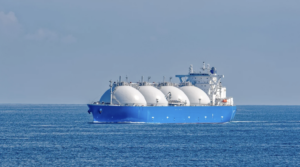
U.S. LNG developer New Fortress Energy had sought to build a floating terminal in Ireland for LNG imports which would supply a 600 MW power plant. Speaking in Ireland’s parliament, its Minister for the Environment, Eamon Ryan, noted that the government’s policy is to move away from natural gas, especially if produced using hydraulic fracking. Some call it a “brave move” given potential natural gas supply shortages. The country seeks 80% renewables by 2030; currently it is at a 37% level.
Ireland is taking a leadership role in Europe on climate while other European countries are backpedaling. Germany installed three new floating LNG facilities and more are planned. France made a U-turn on natural gas following the war in Ukraine and signed a U.S. LNG supply deal. The U.K. announced in September that it is stepping back from some of its most aggressive net zero targets.
Northeast Offshore Wind’s Ups and Downs
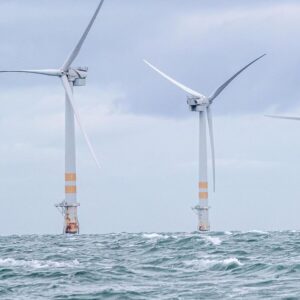
All of a sudden, there’s wind power being harvested in the ocean waters off the Northeast of America, on the outer continental shelf. First in Rhode Island waters and soon New Jersey! The federal government has approved utility-scale offshore wind leases in Massachusetts (Vineyard Wind), New York (South Fork Wind), New Jersey (Ocean Wind), and Connecticut (Revolution Wind).
Offshore wind projects are in the works from Massachusetts to South Carolina with ocean plots being leased out by the federal Bureau of Ocean Energy Management (BOEM). There are wind leases off Virginia, Maryland, and Delaware – known as “Wind Energy Areas” as designated and licensed by the BOEM.
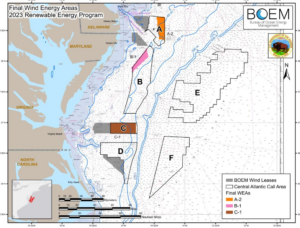
Image Courtesy of BOEM
Let’s begin with progress: Vineyard Wind’s first turbine had now had its final blade put in place. The wind farm is 15 miles south of Martha’s Vineyard, each turbine almost three times as tall as the Statue of Liberty. The 800 MW, 62 turbine project is being developed by Avangrid and a Danish investment firm, Copenhagen Infrastructure Partners which anticipates partial production beginning in December of 2023.
Construction is also underway with the South Fork Wind Farm. It’s a 130 MW project of 12 turbines located 30 miles east of Montauk Point, NewYork. An underwater cable will connect the wind farm to East Hampton on Long Island. The farm is being built by the Danish company, wind giant, Orsted.
The Garden State has a goal of 7.5 GW of offshore wind by 2035. Now 98 wind turbines comprising 1.1 GW of capacity are planned 15 miles southeast of Atlantic City, New Jersey. The wind farm known as Ocean Wind 1 is also owned by Orsted. It will feature GE Haliade 12 MW turbines. Orsted had to put up $100 million to guarantee that the wind farm will be online by December 2025.

Image Courtesy of Electrek
Today Orsted is building wind farms from Rhode Island to Maryland with a combined generating capacity of 5 GW. It is at the speartip of a budding industry. And with that comes a new supply chain… manufacturing facilities across the Midwest, vessel construction on the Gulf Coast, steel fabrication in the south, and much more.
But these are contentious days in the offshore wind industry. Cost overruns are being disputed and rate impacts with and without offshore wind are inevitable. In Massachusetts, Eversource Energy, National Grid, and Unitil have reached an agreement with Avangrid to terminate the PPA for the 1,223 MW proposed offshore wind farm known as Commonwealth Wind. Avangrid requested termination in December due to “global economic headwinds.” It agreed to pay utilities $48 million for termination if approved by its regulators. In related news, Rhode Island Energy will not move forward with PPA with Orsted and Eversource with their joint project Revolution Wind 2 calling it too expensive.
Wind companies have faced higher costs and now are demanding to amend their contracts for offshore wind power. The situation has been all over the media in the Northeast, given potential rate impacts due to increased costs for wind. Failing to update the contract prices, some argue, could result in contract terminations, which could result in even higher cost resources in the future. So accept higher prices now? In some areas, residential rates may rise by 1.5 – 2.5%, on average by $4.67 a month. What are these unforeseen wind costs all about? Where did they come from?
Orsted claims $2.35 billion in “impairments” on its U.S. offshore wind portfolio to supply chain challenges, possible ineligibility for tax credits, and interest rates. Developers faced unexpected inflation. Without increases the projects may not be viable according to Equinor and BP which are jointly developing three offshore wind projects. Orsted, and other developers are seeking a 48% increase in their contract prices for offshore wind, up to $167.25/MWh.
Well beyond offshore wind, the New York Public Service Commission is considering petitions to adjust contract terms for 91 renewable energy projects. These total 13.5 GW in capacity and would supply 25% of New York’s load by 2030. The developers had been seeking billions of dollars in additional funding for existing contracts. Naturally the State’s utilities are opposed to the contract amendments, concerned about setting bad precedents. And then the offshore wind decision: New York State regulators are not allowing wind developers to change the terms of their contracts. The State denial could result in canceled contracts.
Flanigan’s Ego-Logic Podcast Updates

Use the links below to check out our recent podcasts. And you can always go to Spotify and type in “Ted Flanigan” to find our library of podcasts.
Recently Released:
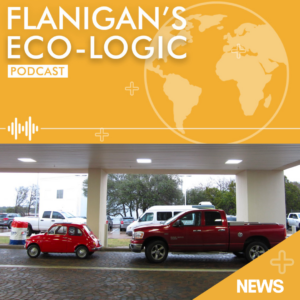
In EcoNet News, Volume 25, Issue #10, Ted shares perspective on tackling the car bloat and transforming social expectations. He also highlights Green Mountain Power’s plan for zero outages by 2030, heat pumps, filling the tree equity gap, rural electrification in the Maldives, Ireland rejecting a new fossil fuel import facility, and wind power being harvested in the ocean waters off the Northeast of America.
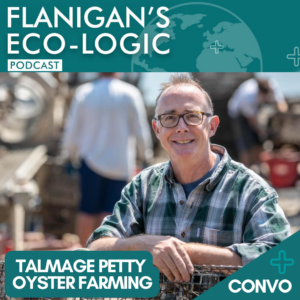
In this episode of Flanigan’s Eco-Logic, Ted speaks with Talmage Petty, Founder and President of Hollywood Oyster Company. Talmage is an oyster farmer. He jokes that at times, he considers himself to be an “Oyster Whisperer.”
Talmage discusses the sustainable aspect of oyster farming, digging into the topic of aquaculture versus wild harvest. He shares that his operation at Hollywood Oyster farm sustainably contributes to the restoration of the Chesapeake Bay, with its millions of oysters filtering waters, and by its creation of habitat in and around its thousands of growing cages.
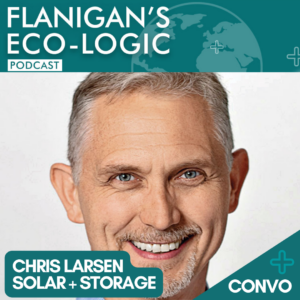
In this episode of Flanigan’s Eco-Logic, Ted speaks with Chris Larsen, Senior Director for Clean Energy at Dynapower. He entered the clean energy field as Policy Director for North Carolina Clean Energy Technology Center. He also spent ten years with ABB in various roles in inverter design, R&D, and more.
As a 25‐year clean energy veteran, Chris has been instrumental in positioning Dynapower as the leading power electronics provider for hybrid solar plus storage systems. He partnered with other industry leaders to bring DC‐DC technology to life, and he discusses that and its broader application. Chris is now responsible for commercial applications including renewable energy, microgrids, e‐mobility, and green hydrogen.
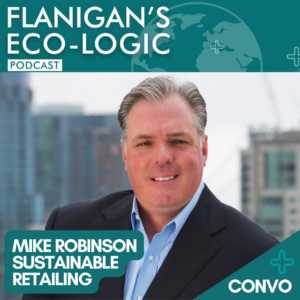
In this episode of Flanigan’s Eco-Logic, Ted speaks with Mike Robinson, Head of Retail Operations and a Founding Member for The Eighth Notch (aka T8N), an early stage startup in the Logistics-tech space. He provides expert advice regarding digital retailing, and brings over 30 years of experience from both management consulting and executive operator perspectives.
Mike discusses the how and why behind an urgent need for the retail industry to adopt more sustainable solutions and critical insights into how both small and large-scale retail brands are beginning to align with demand from investors and consumers for eco-conscious alternatives and operations.
He shares the mission of Eighth Notch, which is to reduce the number of deliveries and create a more sustainable supply chain by ensuring the most sustainable mile is the one never driven. The Eighth Notch is working with retailers and carriers to reduce the number of deliveries and optimize routes. This not only results in significant operational savings for retailers but also contributes to a more sustainable environment by cutting down on carbon emissions. Mike emphasized that the avoidance of emissions, rather than offsetting, is a crucial part of their approach.
